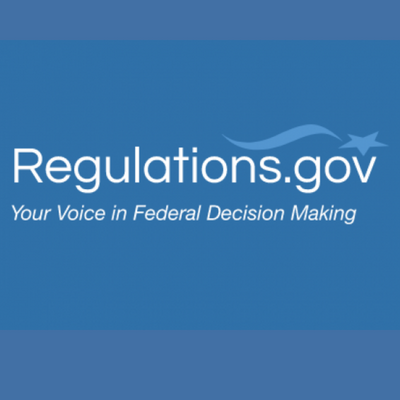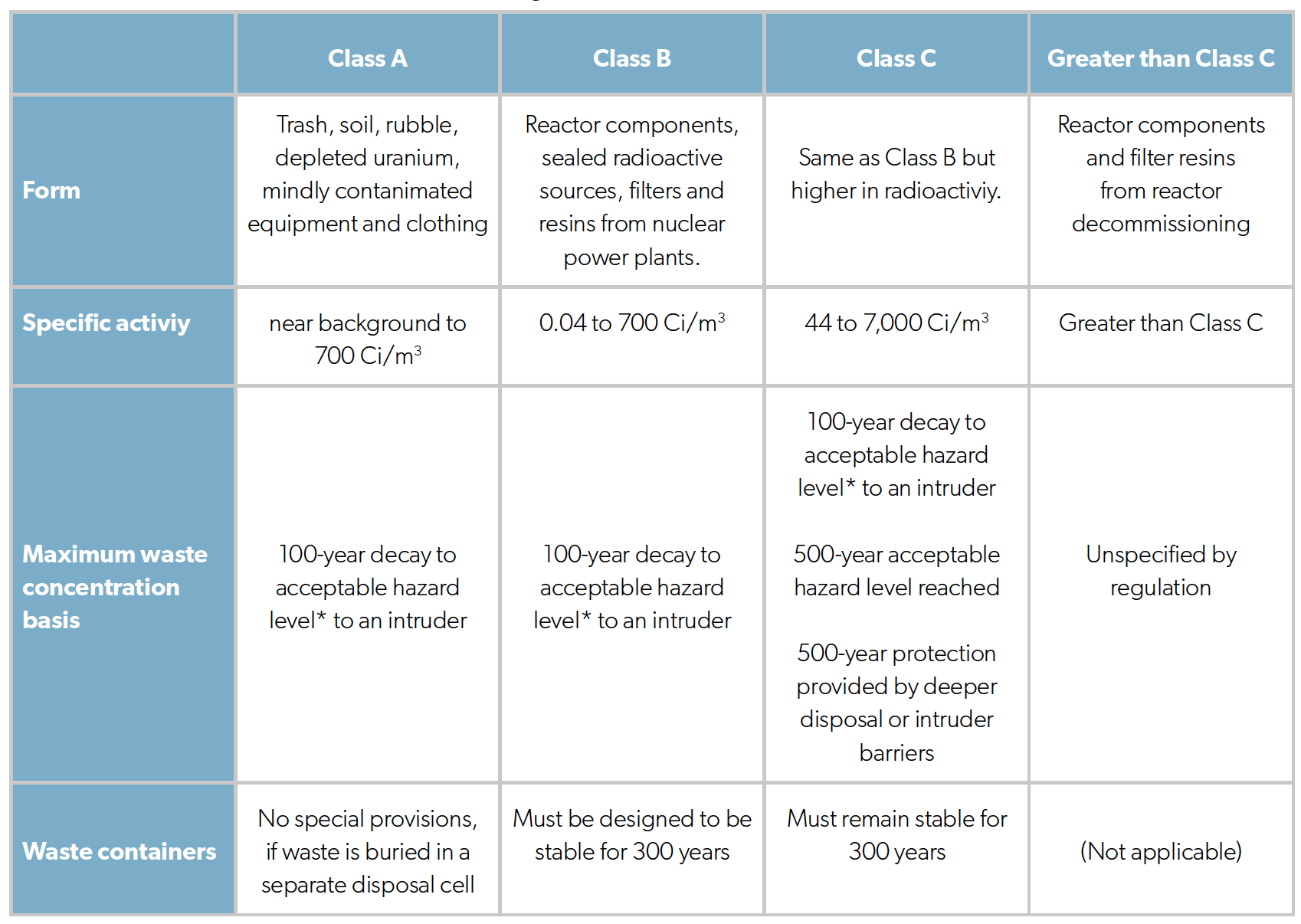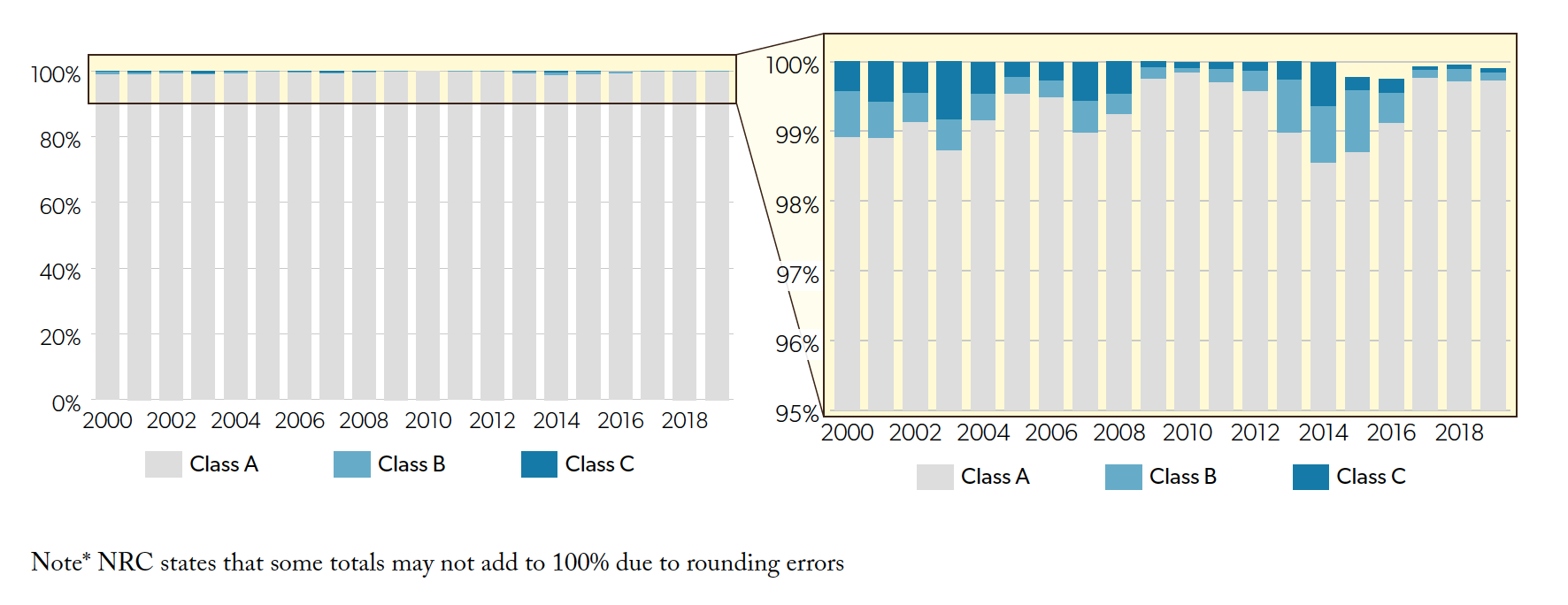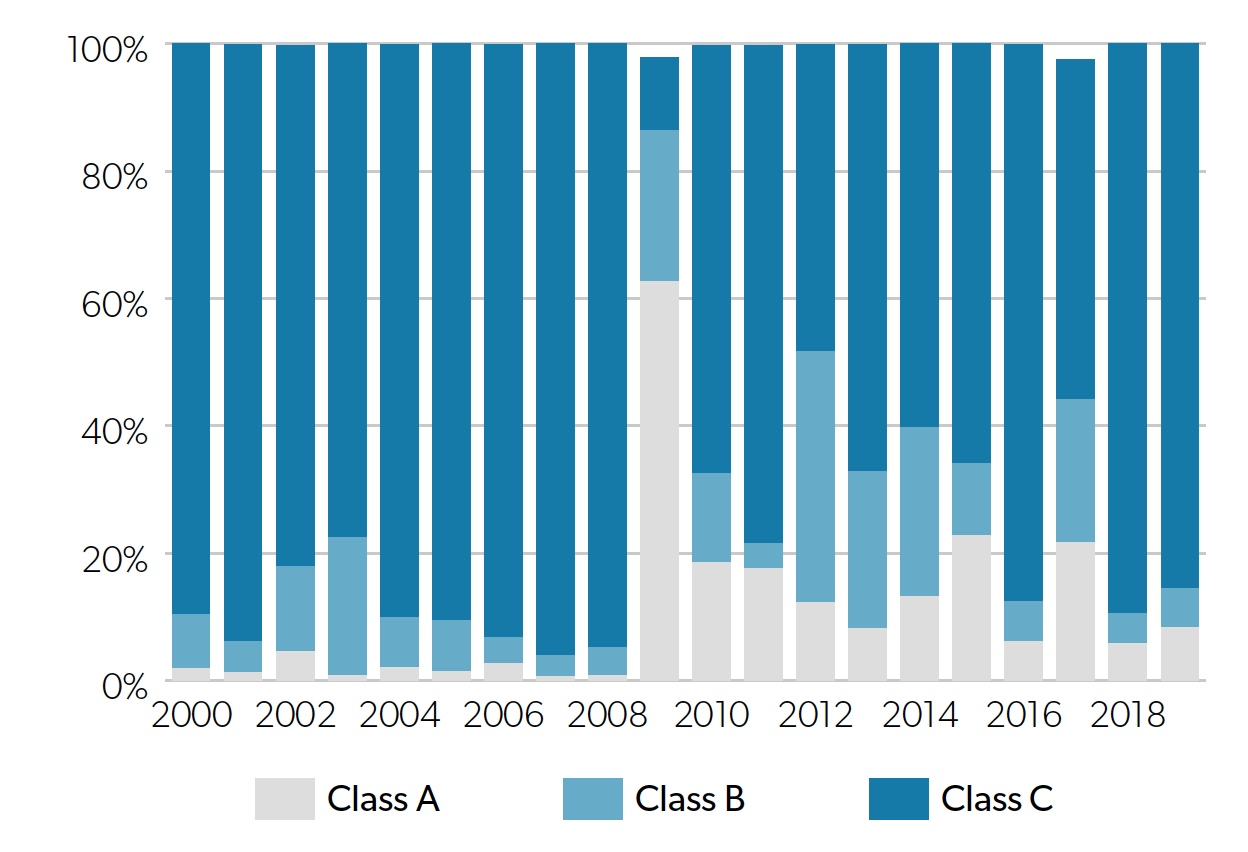Introduction: US Radioactive Waste
There are currently 98 nuclear power plants in the United States. Electricity from those plants constitutes around one-fifth of all electricity produced. The growing demand for zero-carbon energy sources has been driving up interest in nuclear energy in recent years, but there remain some major hurdles to wide-spread nuclear implementation. One of those hurdles is deciding what to do with the radioactive waste products produced by nuclear reactors.
The Nuclear Regulatory Commission (NRC) currently designates radioactive waste as either high-level or low-level waste. High-level waste is what people typically think of when they hear about radioactive waste—highly hazardous material that is a byproduct of nuclear reactions. These are the spent fuel removed from a reactor’s core and the waste materials that remain after spent fuel is reprocessed.1“High-Level Waste.” United States Nuclear Regulatory Commission. Aug 23, 2017. https://www.nrc.gov/waste/high-level-waste.html They are also the waste products ultimately destined for Yucca Mountain or a similar underground repository where they will pose no threat to human or environmental health.
Low-level waste (LLW) captures everything else that can be defined as radioactive waste and falls under the jurisdiction of the NRC. The majority of LLW comes from nuclear power plants and military weapons facilities, but also contains waste from medical and research facilities. This includes things like mops, filters, tools, shoe coverings, syringes, medical tubing—anything that may have been exposed to or contaminated by radiation. This wide range of waste products has an equally wide range of potential radioactivity. Some items are no more radioactive than everyday household items, while others may contain very high and therefore dangerous levels of radiation.2“Low-Level Waste.” United States Nuclear Regulatory Commission. Aug 03, 2017. https://www.nrc.gov/waste/low-level-waste.html
The Nuclear Regulatory Commission further divides LLW into three separate categories, known simply as Class A, Class B, and Class C waste. Table 1 outlines the characteristics of each class of waste, from the least hazardous Class A to the most hazardous Class C and beyond (greater than Class C).
Table 1: Low-Level Nuclear Waste Class Designations3 Andrews, Anthony. “ Radioactive Waste Streams: Waste Classification for Disposal.” United States Congressional Research Service. Dec 13, 2006. https://fas.org/sgp/crs/misc/RL32163.pdf
There are currently four operating LLW disposal facilities in the US, located in Andrews County, TX, Barnwell, SC, Clive, UT, and Richland, WA.4“Locations of Low-Level Waste Facilities.” United States Nuclear Regulatory Commission. May 5, 2020. https://www.nrc.gov/waste/llw-disposal/licensing/locations.html Last year, these facilities accepted a total of 4.25 million cubic feet of radioactive LLW. Of that 4.25 million cubic feet, 99.5 “Generator Data.” July 12, 2020. United States Department of Energy. https://mims.doe.gov/GeneratorData.aspx percent by volume was classified as Class A waste. That same waste, however, only accounted for about 10 percent of the total radioactivity of all LLW disposed of in 2019. As shown in Charts 1 and 2, over the last 20 years Class A waste has accounted for over 99 percent of all LLW by volume, but only 3 percent of radioactivity.
Chart 1: Percentage of Total Waste B
Chart 2: Percentage of Total Radioactivity6Ibid
Note* NRC states that some totals may not add to 100% due to rounding errors
Radiation Exposure and Safety
The least radioactive of all Class A waste is referred to as Very Low-Level Waste (VLLW). This waste is not defined by statute, but is generally recognized by the NRC as waste which releases an amount of radiation low enough for it to be disposed of safely in commercial landfills.79 “Backgrounder on Disposals of Very Low-Level Waste Under 10 CFR 20.2002.” United States Nuclear Regulatory Commission – Protecting People and the Environment, May 29, 2020. https://www.nrc.gov/reading-rm/doc-collections/fact-sheets/very-low-level-waste.html. These include items whose radioactivity is on par with naturally occurring and manufactured goods like granite, fertiliser, and coffee beans.8Rosen, Morris “MANAGING RADIOACTIVE WASTE: ISSUES AND MISUNDERSTANDINGS.” Energy & Environment 11, no. 2
(2000): 167-82. www.jstor.org/stable/43734303.
As stated in the proposed interpretive rule, the NRC will authorize exemptions only for the disposal of waste resulting in a 25 millirem (mrem) or less per year cumulative dose. This standard is a safe and reasonable threshold for public radiation exposure. The vast consensus among scientists is that exposure that does not exceed a dose of 1 millisievert (mSv)—100 mrem—to an individual in a year is negligible.911 See Statement from the 1985 Paris Meeting of the International Commission on Radiological Protection. Special Report. Paris, 1985. https://pubs.rsna.org/doi/10.1148/radiology.156.3.4023248. And Baes, Fred. “Regulatory Dose Limits.” Health Physics Society, 2016. https://hps.org/publicinformation/ate/faqs/regdoselimits.html. And Office of Nuclear Material Safety and Safeguards, Regulating the Disposal of Low- Level Radioactive Waste, A Guide to The Nuclear Regulatory Commission’s 10 CFR Part 61. § (1989). https://www.nrc.gov/docs/ML1207/ ML120720225.pdf And Cherry, Simon R, Michael E Phelps, and James A Sorenson. Physics in Nuclear Medicine. ScienceDirect. 4th ed. Elsevier Inc, 2014. https://www.sciencedirect.com/science/article/pii/B978141605198500023X. The International Atomic Energy Agency, which is responsible for setting international safety standards, states that a source which does not exceed 1 mSv in a year is considered viable for deregulation.10“RADIATION PROTECTION AND SAFETY OF RADIATION SOURCES: INTERNATIONAL BASIC SAFETY STANDARDS.” International Atomic Energy Agency. Safety Standards Series No. GSR Part 3. Vienna, Austria: IAEA, 2014.
The average person is exposed to an average of 350 mrem of radiation in total per year, with the vast majority of exposure coming from natural background radiation.11Sorenson, James A. “Perception of Radiation Hazards.” Seminars in Nuclear Medicine16, no. 3 ( July 1986): 158–70. https://doi.org/10.1016/s0001-2998(86)80031-9. The very smallest amount, less than 0.2% of the average individual’s exposure to radiation, actually comes from artificial radiation related to nuclear energy.12Rosen, Morris “MANAGING RADIOACTIVE WASTE: ISSUES AND MISUNDERSTANDINGS.” Energy & Environment 11, no. 2 (2000): 167-82. low levelTo put it into perspective, an individual taking a Paris to New York flight will be exposed to an amount of radiation during that flight that is comparable to someone who has lived by a nuclear power plant for a year. While a healthy fear of nuclear waste and a desire for the responsible handling of it is absolutely necessary, it is equally important to understand that the biological effects of radiation are exposure dependent, meaning if exposure is kept low, the risks will virtually be nonexistent.13Ibid
A study conducted by the United Kingdom’s Health Protection Agency’s radiation protection division examined the effects of disposing of VLLW at commercial landfill sites. Aiming to calculate acceptable dosages to maintain safe standards, the study found that disposal of waste in many cases does not exceed safety limits, but that there are some radionuclides that are, in some scenarios, dangerous or above the recommended dose criterion. This means that while a majority of VLLW may be safely disposed of in landfills, proper tracking and reporting is needed to ensure adequate safety levels.14Chen, Q. Q., Kowe, R., Mobbs, S. F., & Jones, K. A. (2007, March). Radiological Assessment of Disposal of Large Quantities of Very Low Level Waste in Landfill Sites(UK, HPA Radiation Protection Division). Retrieved July, 2020, from https://assets.publishing.service.gov.uk/government/uploads/system/uploads/attachment_data/file/340124/HpaRpd020.pdf
Several other studies have been conducted with radiation workers, a group exposed to a much higher level of radiation than the general public, to calculate the risks of radiation exposure. These studies have found no significant connection between radiation exposure at regulated levels and health risks.15Rosen, Morris “MANAGING RADIOACTIVE WASTE: ISSUES AND MISUNDERSTANDINGS.” Energy & Environment 11, no. 2 (2000): 167-82. Additionally, there has been no evidence of an increased risk of cancer in population groups living in locations of naturally higher background radiation, such as higher altitudes.16Ibid. The risks of disposing of VLLW are similarly low and can be adequately managed through the proposed exemption process.
History of Very Low-Level Waste Management
An increasing surplus of nuclear waste, specifically Very Low-Level Waste, and the lack of a consistent and effective disposal system has been the cause of debate and uncertainty within the atomic energy community and the Nuclear Regulatory Commission for years. The Low-Level Radioactive Waste Policy Act (LLRWPA) of the 1980s and the Low-Level Radioactive Waste Policy Amendments Act (LLRWPAA) of 1985 were both passed for the purpose of lightening the burden of waste disposal by creating a more efficient and widespread system based on state cooperation under multi-state compacts.17 Geer, Koren. “Below Regulatory Concern: The Nuclear Regulatory Commission’s Solution for Radioactive Waste Management.” Fordham Environmental Law Review 2, no. 2 (2011).
Section 10 of the LLRWPAA also required the NRC to establish a level for radioactivity below which regulatory oversight of waste could be deemed unnecessary. In 1990, NRC began the process of defining this standard, known as Below Regulatory Concern (BRC). This would have potentially deregulated the very lowest levels of Class A waste, allowing them to be disposed of in public facilities and landfills.18Below Regulatory Concern: A Guide to the Nuclear Regulatory Commission’s Policy on the Exemption of Very Low-Level Radioactive Materials, Wastes, and Practices. Vol. 88. US Nuclear Regulatory Commission, 1990. Not unlike the NRC’s current proposal, the BRC standard was an attempt to establish adequate safety levels in order to maximize the clean-up and decommissioning process, increase NRC efficiency, and reduce strain on LLW sites by limiting the amount of waste directed to them.19Walker, J Samuel, and Thomas R Wellock. A Short History of Nuclear Regulation, 1946–2009. US Nuclear Regulatory Commission, 2010. This policy, however, was met with public and congressional backlash, and by 1993 NRC had withdrawn all BRC statements.20“NRC WITHDRAWS BELOW REGULATORY CONCERN POLICY STATEMENTS.” nrc.gov, August 18, 1993. US Nuclear Regulatory Commission. https://www.nrc.gov/docs/ML0037/ML003702922.pdf.
Other attempts have been made at licensing new LLW facilities in order to adequately deal with radioactive waste created in the US, such as the proposed California site in the 1980s, but most attempts have failed due in large part to public opposition.21 Bedsworth, Louise Wells, Micah D. Lowenthal, and William E. Kastenberg. “Uncertainty and Regulation: The Rhetoric of Risk in the California Low-Level Radioactive Waste Debate.” Science, Technology, & Human Values 29, no. 3 (2004): 406-27. As a result, there are currently only 4 licensed facilities
in the United States responsible for disposing upwards of 1 million cubic feet of LLW per year.22Petrella, Michael. “Wasting Away Again: Facing The Low-Level Radioactive Waste Debacle In The United States.” Fordham Environmental Law Journal 5, no. 1 (1993), “Locations of Low-Level Waste Disposal Facilities.” United States Nuclear Regulatory Commission – Protecting People and the Environment, August 9, 2017. https://www.nrc.gov/waste/llw-disposal/licensing/locations.html. The construction and licensing of radioactive waste disposal sites in the US has been a point of contention for every state that has discussed the possibility of developing such a site, and most states suffer from an over-stigmatization and public misconception of LLW.23Bedsworth, Louise Wells, Micah D. Lowenthal, and William E. Kastenberg. “Uncertainty and Regulation: The Rhetoric of Risk in the California Low-Level Radioactive Waste Debate.” Science, Technology, & Human Values 29, no. 3 (2004): 406-27.
It is natural for the NRC to once again be seeking a solution to its waste problem through the recently proposed rule, and it is in the public’s interest to not place unnecessary barriers on any policy that could safely offer alternative disposal methods.
Responses to Request for Comment
(1) This interpretive rule would authorize the transfer of licensed material to persons who hold specific exemptions for disposal without a case-by-case review and approval of the transfers. Do you think that case-by-case review and approval of these transfers is necessary?
No, there is no need for case-by-case review and approval of these transfers according to the standards set forth in this interpretive rule. As mentioned previously, the 25 mrem and below standard is consistent with appropriate levels of public exposure. In fact, a 25 mrem cumulative dose is four times lower than the allowable public exposure threshold and two hundred times lower than the allowable exposure threshold for radioactive workers set forth by the NRC.2426 “NRC Occupational Dose Limits.” United States Nuclear Regulatory Committee. July 12, 2020. https://www.nrc.gov/images/about-nrc/radiation/dose-limits.jpg.
Additionally, section V of the interpretive rule establishes five criteria by which all exempted facilities will be analyzed. These include burial method, site characteristics, and dose assessments. Any site that appropriately meets these criteria should not also be subject to a case-by-case analysis of each waste transfer.
However, ensuring that each exemption holder is held to these safety standards will remain crucial to ensuring no harm to the general public.
These safety standards eliminate the need for case-by-case reviews currently required under 10 CFR 20.2002.
(1) Transboundary transfer of VLLW associated with the approved disposal actions is an important consideration. What issues associated with transboundary transfer of VLLW should be considered with this interpretive rule?
We do not wish to comment.
(2) 10 CFR 20.2006 states that “[a]ny licensee shipping radioactive waste intended for ultimate dis- posal at a licensed land disposal facility must document the information required on NRC’s Uniform Low-Level Radioactive Waste Manifest and transfer this recorded manifest information to the in- tended consignee in accordance with Appendix G to 10 CFR Part 20.” Should the exempt persons au- thorized to dispose of certain VLLW that would be considered §20.2001 “authorized recipients” under this proposed interpretive rule be required to use Uniform Waste Manifests (consistent with §20.2006) for waste transferred to the exempted disposal facility?
We believe that there is no harm in continuing to require the use of Uniform Waste Manifests (UWM) as outlined in 10 CFR 20.2006. This is a standard industry practice and there does not seem to be a need to introduce a new system, nor does it seem that eliminating the current use of UWMs would be necessarily advantageous.
10 CFR 20.2006 states that “[a]ny licensee shipping radioactive waste intended for ultimate disposal at a licensed land disposal facility must document the information required on NRC’s Uniform Low-Level
Radioactive Waste Manifest and transfer this recorded manifest information to the intended consignee in accordance with appendix G to 10 CFR part 20.” The NRC should require licensees disposing of material in exempt facilities to complete the Uniform Low-Level Radioactive Waste Manifest, which outlines basic requirements for the disposal and transfer of waste, specifically the documentation of information required on the NRC’s manifest. This includes information such as shipment details, contact information for the facility of origin as well as the destination facility and the transporter, weight, total number of containers, and total radionuclide activity in the shipment.
Each disposal container must also be identified, and specific details regarding each container such as a physical and chemical description of the waste, the total radioactivity per container, and the individual radionuclides in each container must be included; an authorized representative of the waste generator must certify that all this information is correct; the generator must prepare and label waste, and conduct quality assurance on the waste in accordance with the rules and regulations set out in 61.55. Additionally, a waste manifest requires national participation on a massive scale, from generators and processors to collectors and disposers, which creates a system of trust and order between states, and allows for the tracking of all waste streams.
The Uniform Waste Manifest has been called “absolutely necessary for maintaining safety levels” by the NRC, and requirements 31 and 32 of the IAEA International Basic Safety Standards state that maintaining a full record of all waste streams going into exempted facilities is a necessity, given the responsibility of the regulatory body for the enforcement of safety standards.
(1) Are there any other criteria that the NRC should consider when it reviews a request for a specific exemption for the purpose of disposal?
We do not have any additional criteria to suggest.
(2) The regulation in § 20.2001 is currently identified as a compatibility C regulation for purposes of Agreement State compatibility. In light of this proposed interpretive rule, does the compatibility designation raise issues that the NRC should consider?
We have no issues to suggest here. The proposed interpretive rule remains in-line with the stated purpose of a compatibility C regulation.25“Adequacy and compatibility of program elements for agreement state programs.” United States Nuclear Regulatory Commission. April 26, 2018. https://www.nrc.gov/docs/ML1808/ML18081A070.pdf
Conclusion
This interpretive rule is an opportunity for the NRC not only to make its policies regarding the disposal of low-level radioactive waste more consistent, but to also improve the method of disposal for a massive portion of US radioactive waste streams. Allowing the disposal of VLLW at exempted facilities which have met the standards set forth by the NRC provides a safe alternative to our country’s limited nuclear waste storage facilities. This will free up space at those licensed facilities for the storage of waste that is a much higher risk to human safety and environmental health. It is a step in the right direction to streamlining the onerous radioactive waste disposal process in this country.



 Regulations.gov
Regulations.gov

